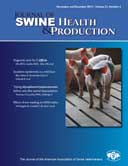Abstract:

A case of exudative epidermitis in a young wild boar from a Spanish game estate
David Risco Pérez, DVM; Pedro Fernández-Llario, PhD; Roser Velarde, PhD; Jesús M. Cuesta, DVM; Waldo L. García-Jiménez, DVM; Pilar Gonçalves, DBS; María Gil, DVM; Alfredo García, PhD; Joaquín Rey, PhD; Luis Gómez, PhD; Javier Hermoso de Mendoza, PhD
Complete article is available online.
PDF version is available online.
Exudative epidermitis, a porcine disease caused by Staphylococcus hyicus, produces serious economic losses in severely affected herds. In this report, we describe a case of exudative epidermitis in a wild boar presenting specific clinical signs. The affected animal was a female approximately 6 months old, with greasy brown exudates around the mouth and eyes and on the neck and legs, separation of the horn at the bulbs of the heels, necrosis of the tips of the pinnae and tail, and focal ulcerative stomatitis. Multiple septic emboli and necrotic foci were observed in the lung. Staphylococcus hyicus isolates were obtained from affected skin and lungs. This disease and others that occur on wild boar farms, while similar to those described in domestic pigs, tend to produce specific clinical signs in wild boar, such as the pneumonic lesions in this case. Exudative epidermitis in this animal was aggravated by these pneumonic lesions. The increasing economic relevance of wild boar farming has led to an increase in the occurrence of infectious diseases. Knowledge about their epidemiological, clinical, and pathological manifestations in wild boar will facilitate prevention, diagnosis, and treatment, reducing the impact on animal health and economics in this new niche swine production.
Keywords: exudative epidermitis, wild boar, Staphylococcus hyicus, pneumonia
![]() Cite as: Risco Pérez D, Fernández-Llario P, Velarde R, et al. A case of exudative epidermitis in a young wild boar from a Spanish game estate. J Swine Health Prod 2013;21(6):304-308.
Cite as: Risco Pérez D, Fernández-Llario P, Velarde R, et al. A case of exudative epidermitis in a young wild boar from a Spanish game estate. J Swine Health Prod 2013;21(6):304-308.
Search the AASV web site for pages with similar keywords.
